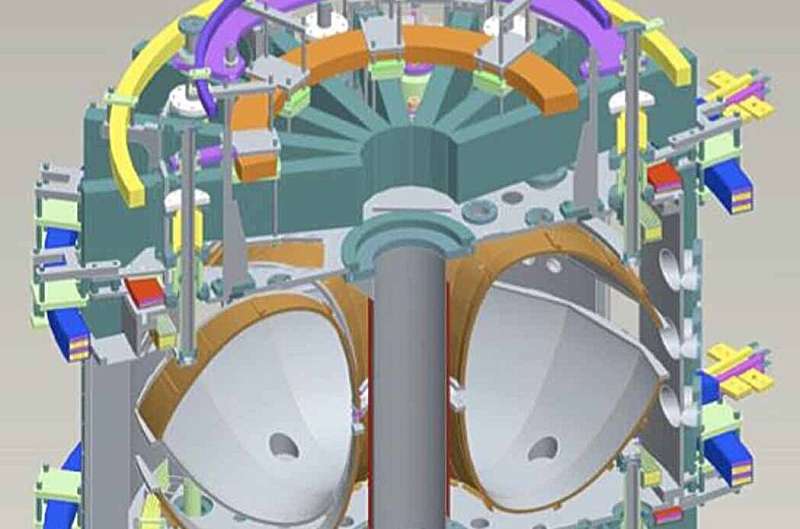This article has been reviewed according to Science X's editorial process and policies. Editors have highlighted the following attributes while ensuring the content's credibility:
fact-checked
trusted source
proofread
Plasma fusion: Adding just enough fuel to the fire

How much fuel can we add to the fire while still maintaining control? Metaphorically speaking, that's the question one team at the U.S. Department of Energy's Princeton Plasma Physics Laboratory (PPPL) has been asking themselves lately.
Now, they believe they have the answer for one particular scenario. It's all a part of the Lab's work to bring energy from fusion to the power grid.
Building upon recent findings showing the promise of coating the inner surface of the vessel containing a fusion plasma in liquid lithium, the researchers have determined the maximum density of uncharged or neutral particles at the edge of a plasma before the edge of the plasma cools off and certain instabilities become unpredictable.
Knowing the maximum density for neutral particles at the edge of a fusion plasma is important because it gives the researchers a sense of how and how much to fuel the fusion reaction.
The research, which is featured in a new paper in Nuclear Fusion, includes observations, numerical simulations and analysis from their experiments inside a fusion plasma vessel called the Lithium Tokamak Experiment-Beta (LTX-β).
The unique environment of LTX-β
LTX-β is one of many fusion vessels around the world that holds plasma in a donut shape using magnetic fields. Such vessels are known as tokamaks. What makes this tokamak special is that its inner walls can be coated, almost completely, in lithium. This fundamentally changes the wall behavior, as the lithium holds on to a very high percentage of the hydrogen atoms coming off the plasma.
Without the lithium, far more hydrogen would bounce off the walls and back into the plasma. In early 2024, the research team reported that this low recycling environment for hydrogen keeps the very edge of the plasma hot, making the plasma more stable and providing room for a larger volume of plasma.
"We are trying to show that a lithium wall can enable a smaller fusion reactor, which will translate into a higher power density," said Richard Majeski, a managing principal research physicist at PPPL and head of LTX-β. Ultimately, this research could translate into the cost-effective fusion power source the world needs.
Now, the LTX-β team has published additional findings showing the relationship between the fuel for the plasma and its stability. Specifically, the researchers found the maximum density of neutral particles at the edge of plasma inside LTX-β before the edge starts to cool, potentially leading to stability problems.
The researchers believe they can reduce the likelihood of certain instabilities by keeping the density at the edge of the plasma below their newly defined level of 1 x 1019 m–3. This is the first time such a level has been established for LTX-β, and knowing it is a big step in their mission to prove lithium is the ideal choice for an inner-wall coating in a tokamak because it guides them toward the best practices for fueling their plasmas.
In LTX-β, the fusion is fueled in two ways: using puffs of hydrogen gas from the edge and a beam of neutral particles. Researchers are refining how to use both methods in tandem to create an optimal plasma that will sustain fusion for a long time in future fusion reactors while generating enough energy to make it practical for the power grid.
Refining methods for retaining an even temperature across the plasma
Physicists often compare the temperature at its edge to its core temperature to assess how easy it will be to manage. They plot these numbers on a graph and consider the slope of the line. If the temperature at the inner core and outer edge are nearly the same, the line is almost flat, so they call that a flat temperature profile. If the temperature at the outer edge is significantly lower than the temperature at the inner core, scientists call it a peaked temperature profile.
"The team determined the maximum density of neutral particles beyond the edge of a plasma that still allows for a flat-edge temperature profile. Going beyond that number of neutrals at the edge definitely will drop your edge temperature, and you will end up in a peaked temperature profile," said Santanu Banerjee, a staff research physicist at PPPL and lead author on the new paper.
"That same neutral density is the threshold for instabilities known as tearing modes. Beyond that density, tearing modes tend to get destabilized, cause threats to the plasma, and may stop the fusion reaction if left uncontrolled."
If the instabilities become too large, the fusion reaction will end. In order to support the power grid, researchers are figuring out the best ways to manage a fusion plasma so that the reaction is stable.
Banerjee and Majeski worked with several other researchers on the paper, including PPPL's Dennis Boyle, Anurag Maan, Nate Ferraro, George Wilkie, Mario Podesta, and Ron Bell.
Work on the project continues. PPPL engineer Dylan Corl is optimizing the direction in which the neutral beam, which is used to heat the plasma, is injected into the tokamak. "We're basically creating a new port for it," Corl said. He uses a 3D model of the LTX-β, testing different beam trajectories to ensure the beam won't hit another part of the equipment, such as tools used to measure the plasma. "Finding the best angle has been a challenge, but I believe we've got it now," Corl said.
More information: Santanu Banerjee et al, Investigating the role of edge neutrals in exciting tearing mode activity and achieving flat temperature profiles in LTX-β, Nuclear Fusion (2024). DOI: 10.1088/1741-4326/ad2ca7
Provided by Princeton Plasma Physics Laboratory




















